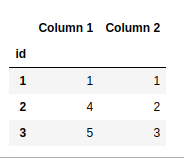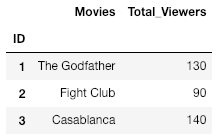在Pandas groupby中用字典组合多个列
让我们看看如何在Pandas中使用groupby与字典的方式,借助不同的例子来组合多列。
示例 #1:
# importing pandas as pd
import pandas as pd
# Creating a dictionary
d = {'id':['1', '2', '3'],
'Column 1.1':[14, 15, 16],
'Column 1.2':[10, 10, 10],
'Column 1.3':[1, 4, 5],
'Column 2.1':[1, 2, 3],
'Column 2.2':[10, 10, 10], }
# Converting dictionary into a data-frame
df = pd.DataFrame(d)
print(df)
输出:

# Creating the groupby dictionary
groupby_dict = {'Column 1.1':'Column 1',
'Column 1.2':'Column 1',
'Column 1.3':'Column 1',
'Column 2.1':'Column 2',
'Column 2.2':'Column 2' }
# Set the index of df as Column 'id'
df = df.set_index('id')
# Groupby the groupby_dict created above
df = df.groupby(groupby_dict, axis = 1).min()
print(df)
输出:

解释:
- 这里我们将第1.1栏、第1.2栏和第1.3栏归入第1栏,将第2.1栏、第2.2栏归入第2栏。
- 注意,每一列的输出是各列的最小值,即在第1列中,第一行的值是第1.1列第1行,第1.2列第1行和第1.3列第1行的最小值。
示例 #2:
# importing pandas as pd
import pandas as pd
# Create dictionary with data
dict = {
"ID":[1, 2, 3],
"Movies":["The Godfather", "Fight Club", "Casablanca"],
"Week_1_Viewers":[30, 30, 40],
"Week_2_Viewers":[60, 40, 80],
"Week_3_Viewers":[40, 20, 20] };
# Convert dictionary to dataframe
df = pd.DataFrame(dict);
print(df)
输出:

# Create the groupby_dict
groupby_dict = {"Week_1_Viewers":"Total_Viewers",
"Week_2_Viewers":"Total_Viewers",
"Week_3_Viewers":"Total_Viewers",
"Movies":"Movies" }
df = df.set_index('ID')
df = df.groupby(groupby_dict, axis = 1).sum()
print(df)
输出:

解释:
- 在这里,注意到即使’Movies’没有被合并到另一列中,它仍然必须出现在groupby_dict中,否则它就不会出现在最终的数据框架中。
- 为了计算Total_Viewers,我们使用了.sum()函数,将各行的所有数值相加。
 极客教程
极客教程